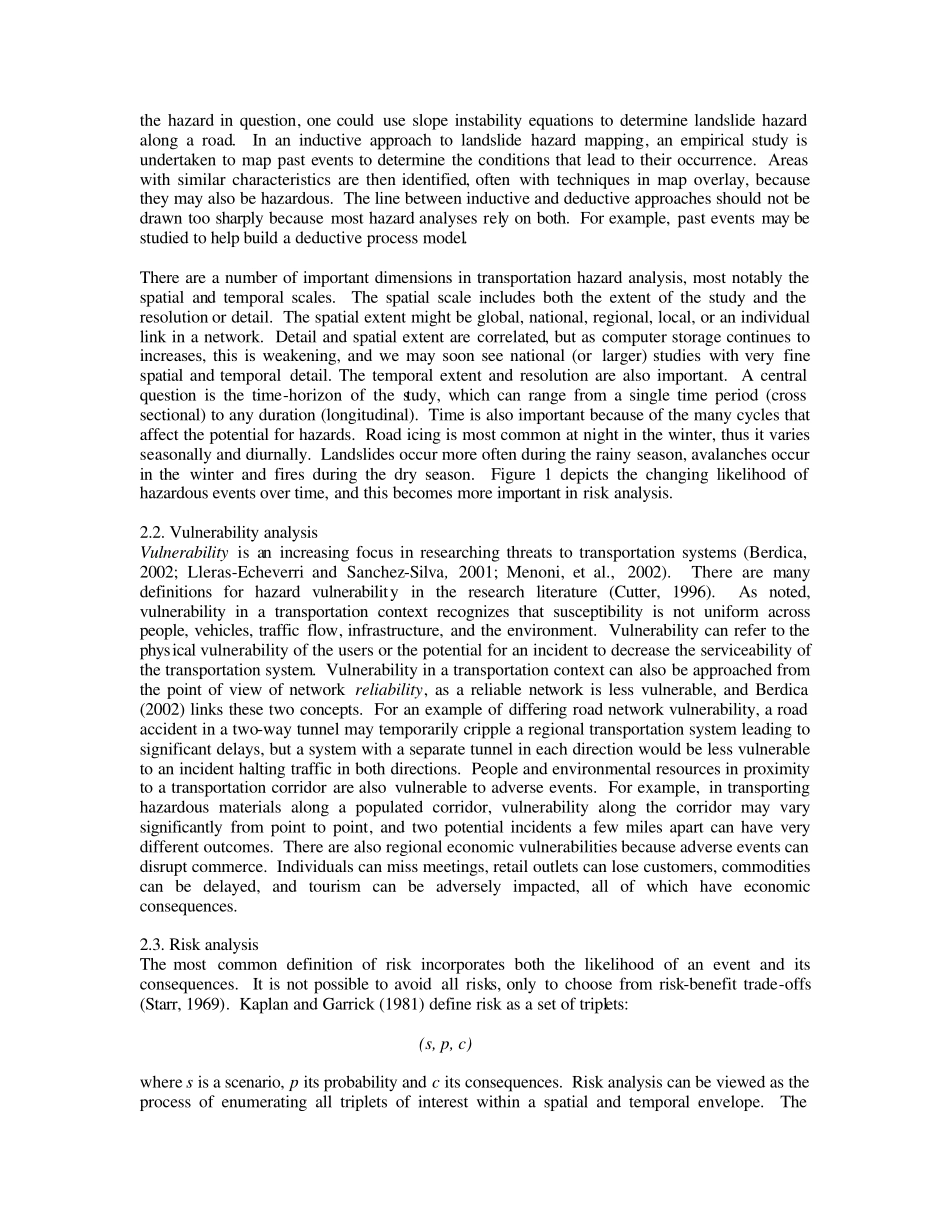TransportationhazardsThomasJ.CovaandStevenCongerCenterforNaturalandTechnologicalHazardsDepartmentofGeographyUniversityofUtahSaltLakeCity,UT84112-9155cova@geog.utah.edu(801)581-7930,FAX:(801)581-8219Citation:Cova,T.J.,andConger,S.(2004)Transportationhazards,inHandbookofTransportationEngineering,M.Kutz(ed.),McGrawHill,NewYork,pp.17.1-17.24.1.IntroductionTransportationsystemsaredesignedtomovepeople,goodsandservicesefficiently,economicallyandsafelyfromonepointontheearth’ssurfacetoanother.Despitethisbroadgoal,therearemanyenvironmentalhazardsthatcommonlydisruptordamagethesesystemsatavarietyofspatialandtemporalscales.Whereasroadcurvegeometryandotherengineeredhazardscanbeaddressedthroughdesign(Persaud,etal.,2000),hazardssuchasextremeweather,landslidesandearthquakesaremuchmoredifficulttopredict,manageandmitigate.Theseadverseeventscandramaticallyreducenetworkserviceability,increasecosts,anddecreasesafety.Theeconomiclivelihoodofmanyindividuals,firms,andnationsdependsonefficienttransportation,andthisisembodiedintwentieth-centuryinnovationslikejust-in-timemanufacturingandovernightshipping.Asthemovementofpeople,goods,andservicesincreasesatallscalesduetopopulationgrowth,technologicalinnovation,andglobalization(JanelleandBeuthe,1997),thesystematicstudyoftheseeventsbecomesincreasinglyimportant.Researchintheareaoftransportationhazardsaidsgovernmentsinallocatingscarceresourcestothefourphasesofemergencymanagement:mitigation,preparedness,responseandrecovery.Newfieldsofstudyareemergingtoaddressthisneed,asinthecaseofHighwayMeteorology,whichfocusesontheadverseeffectsofextremeweatherontransportationsystems(PerryandSymons,1991).ThegrowingimportanceofthisparticularfieldintheU.S.canbeseenintherecentpublicationof,“WeatherInformationforSurfaceTransportation–NationalNeedsAssessmentReport(OFCM,2002).”Sometransportationagenciesorganizespecialteamstomanageandmitigatetheeffectsofoneormoreofthesehazards.Recurrenceintervalsforaneventspanfromdailytocenturies,whiletheassociatedconsequencesrangefrominconvenienttocatastrophic.Insomecasesoneeventmaycauseanother–torrentialraincantriggeralandslidethatblocksaroad.Someoccurunexpectedly,whileothersarrivewithsignificantwarning,butallareamenabletosomelevelofpredictionandmitigation.Transportationsystemsalsocreatehazards.Acceleratedmovementcomeswithrisks,andthecorrespondingaccidentsthatoccurdisruptlivesandtransportationsystemsdaily.Vehiclescollide,trainsderail,boatscapsize,andairplanescrashoftenenoughtokeepemergencymanagersandnewsreportersbusy.Thetransportationofhazardousmaterials(HazMat)isacontroversialexampleinthisregardbecauseitplacessubstantialinvoluntaryrisksonproximalpeopleandtheenvironment.FromtheLusitaniatotheWorldTradeCenter,weareoccasionallyremindedthattransportationdisasterscanbeintentionalacts.Lesser-knowntransportationhazardsincludeelevatedirrigationcanals,gaspipelines,andelectricaltransmissionlines.Intramodalrisksarepresentinmanytransportationsystems,asinwaketurbulencebehindlargeaircraft(Gerz,etal.,2002;Harris,etal.,2002),butintermodalrisksarealsoasignificantfactor–atrainmightcollidewithatruckatanat-gradecrossing(AustinandCarson,2002;PanchaanathanandFaghri,1995),orariverbargemightbumpabridgeleadingtothederailmentofatrain.Transportationsystemsthataredisruptedbyahazardouseventalsoplayacriticalroleinemergencymanagement.Transportationlifelinesaregenerall...



 优质VIP
优质VIP 优质VIP
优质VIP 优质VIP
优质VIP 优质VIP
优质VIP 优质VIP
优质VIP 优质VIP
优质VIP 优质VIP
优质VIP 优质VIP
优质VIP 优质VIP
优质VIP 优质VIP
优质VIP